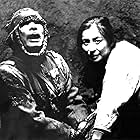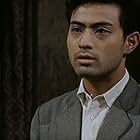Ashita no Joe is a movie adapted from the manga of the same name. The story is set in the 1960s and 70s, with its story centred around a distraught young man, Joe, played by Tomohisa Yamashita. His character is pretty close to the manga's depiction, of him growing up to be a wayward child due to the abandonment by his parents when he was younger. He meets Danpei Tange, played by Teruyuki Kagawa, who spotted his talent in boxing and expressed much eagerness to groom him into a pro-boxer. He rejected him over several occasions but eventually accepted his proposal after encountering Rikiishi, played by Yusuke Iseya.
The choice of Yamashita, one of the more recognizable idols from Japan, is probably crucial to the movie. He sparks enough conversation and curiosity about the movie among crowds which are not that familiar or akin to the manga. Contrary to belief that porcelain faced idols simply can't act, Yamashita might have just set a new standard. He has set up the character Joe well, and displayed great emotional depth and left immense visual impact on subsequent emotional scenes. Both Iseya and Yamashita deserve the same amount of recognition with regards to the extravagant amount of effort put in even before filming. The training they went through were tough, such that their sparring scenes were nowhere close to amateurish. In fact, their professionalism and moves were highly praised by pro-boxers who watched their movie. In addition to that, to achieve a toned body, Yamashita even followed a strict diet over the course of filming, and lost 8 kg. Kudos to their great dedication and professionalism!
For a boxing movie, good fight choreography is definitely important. In this respect, the movie has scored well too. The portrayal of the sport itself is unlike what we commonly think of, that boxing is brutal and sheer violent. Instead, the sport was portrayed to have a profound impact on the sportsmen, and each scene was elegantly shot. By that it means it recreates the impression of the sport for the viewers, where not only fists and violence triumph. Creative angles and new technology are employed to make such visual impacts possible, but they were not too high tech and fitted well into the set-up of the movie (recall: set in the 60s/70s). Strong symbolism was also appropriately used to convey the boxer's innermost passion.
Apart from the action sequences, there was also a great deal of balance in the depiction of the strong bonds within the relationship network. Be it between Rikiishi and Joe, or Joe and the villagers at the slum, or Joe and his trainer Tange, there were clearly strong emotional tugs. At first, Joe lived without purpose, and was avoided by villagers who had virtually no hope for a better tomorrow. However once his passion for boxing was evoked by Rikiishi, he ignited the same hope in the villagers, as well as his trainer, tearing down the barriers in between. The representation of the transformation and intricate relational ties were outstanding and for the most, really affective.
Overall, the movie has more to offer than expected. The adaptation of this manga into a real-life form is exceedingly well done. For fan or non-fan alike, there is probably a thought or two that will cling on to you as you watch this movie.













